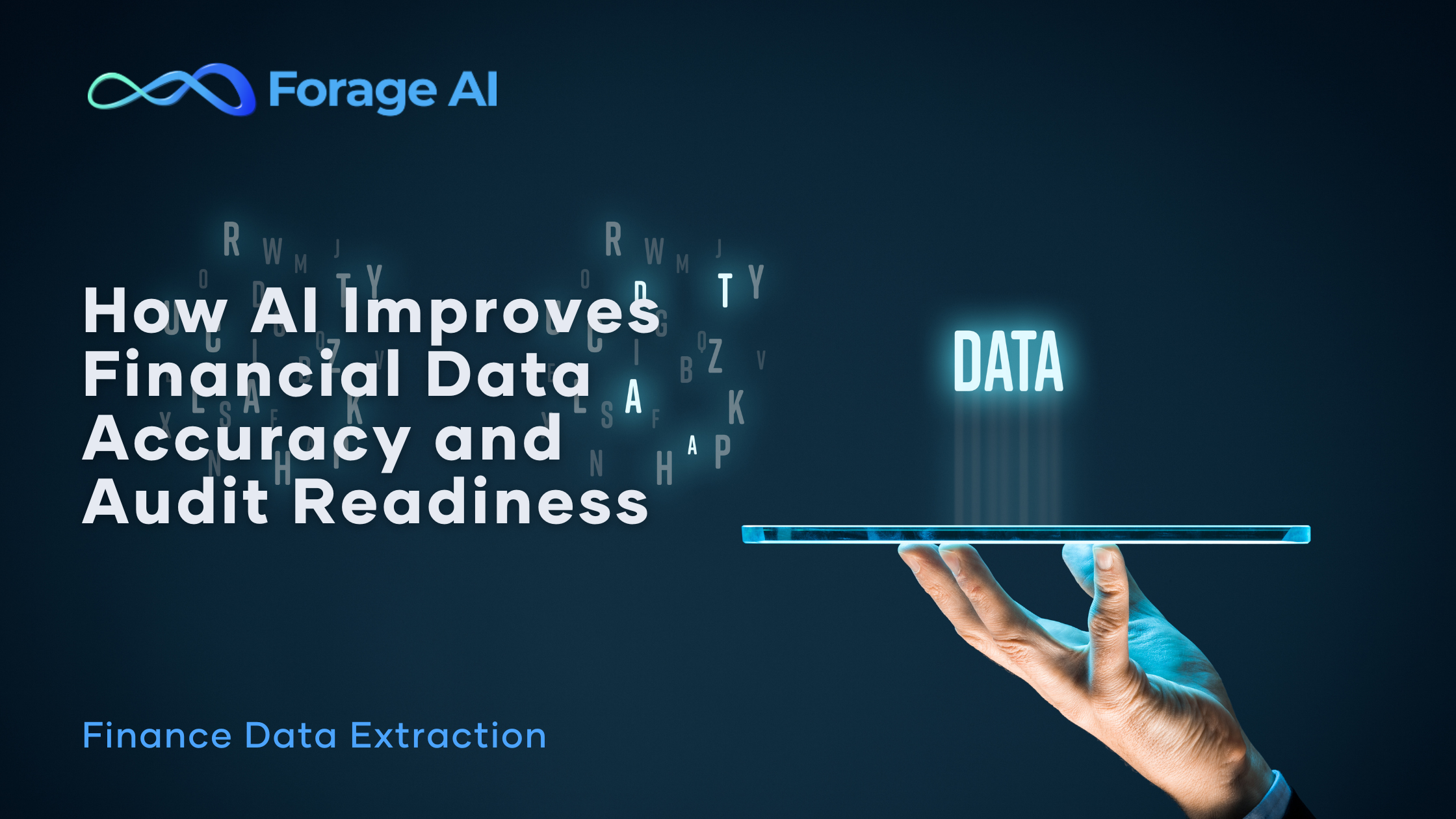You’re three weeks from a major audit. Your team is buried in spreadsheets, cross-referencing invoices, and manually validating transaction records. Someone finds a discrepancy in Q2 data. Now you’re scrambling.
This stressful scenario plays out constantly in finance departments because manual data processes simply cannot keep pace with modern regulatory demands and business complexity.
Here’s what the numbers tell us: Organizations in the financial sector experience an average annual loss of $15 million due to poor data quality, according to Gartner. When audit season arrives, these quality issues become critical vulnerabilities.
AI-driven automation in financial services is the way to go. It is fundamentally more accurate, significantly faster, and built for audit readiness from the ground up.
Why Financial Data Accuracy Matters More Than Ever
Financial leaders face mounting pressure from regulators demanding real-time reporting, stakeholders expecting instant insights, and CFOs requiring accurate forecasts immediately. Yet traditional data management introduces critical challenges:
- Manual entry errors compound quickly. A single misplaced decimal in transaction data cascades through reports, forecasts, and compliance filings. Research shows manual data entry has error rates around 1%, which sounds small until you are processing millions of transactions.
- Reconciliation becomes time-consuming. FP&A teams spend the majority of their time collecting and validating data, leaving little room for high-value analysis.
- Audit trails are fragmented. When data lives across multiple systems with inconsistent formats, proving compliance becomes a nightmare. You cannot demonstrate accuracy if you cannot trace the data’s lineage.
The consequences are significant. A survey by Mosaic Smart Data found that 66% of banks struggle with data quality and integrity, and 83% lack real-time access to transaction data and analytics due to fragmented systems. Data operations teams juggle engineering, analytics, compliance, and leadership coordination while trying to maintain evolving quality standards.
How AI Transforms Financial Data Processing
AI does not just speed up your current processes; it fundamentally redesigns them for accuracy and compliance.
AI-powered Intelligent Document Processing (IDP)
Modern AI reads invoices, receipts, purchase orders, and financial statements like a trained accountant—but with perfect consistency.
Advanced AI systems combining computer vision and large language models achieve near 100% accuracy in identifying essential fields, including supplier details, amounts, VAT rates, and payment terms. More importantly, they learn from corrections. When your team flags an error, the system improves its future performance.
Automated Reconciliation and Validation
AI systems cross-reference data across sources in real-time. They flag discrepancies instantly and identify patterns that indicate fraud or errors. Crucially, they ensure every transaction has a complete audit trail from source to report. This process happens continuously, not just at month-end, so you can easily discover and fix problems.
Predictive Error Detection
The smartest AI systems do not just find errors—they predict where they will occur. By analyzing historical data patterns, these systems identify high-risk transactions, unusual patterns, and potential compliance issues before they become problems. Your team investigates 10 flagged transactions instead of manually reviewing 10,000.
Use Cases: Where AI Delivers Maximum Impact
Let’s look at specific scenarios where AI-powered accuracy makes the biggest difference.
Investment Firm Document Processing
The Challenge: Processing 50,000+ monthly documents—trade confirmations, statements, regulatory filings, and third-party reports. Manual processing requires extensive staff and still produces errors that trigger compliance reviews.
The AI Solution: Automated extraction and validation across the entire document workflow. The system handles everything from standardized forms to complex, unstructured reports.
The Impact: Processing time drops from days to hours. Error rates fall below 2%. Teams refocus on analysis instead of data entry. Most importantly, zero compliance issues in subsequent audit cycles.
Multi-Jurisdictional Compliance Reporting
The Challenge: Global financial institutions must report to regulators in multiple countries, each with different formats, timing requirements, and data specifications. Manual coordination leads to missed deadlines and reconciliation errors.
The AI Solution: Intelligent systems that understand jurisdiction-specific requirements and automatically format data accordingly. Built-in validation ensures completeness before submission.
The Impact: Reduced regulatory penalties. Faster reporting cycles. Clear audit trails showing exactly how data was transformed for each jurisdiction.
High-Volume Transaction Monitoring
The Challenge: Processing millions of transactions daily for fraud detection and compliance. Traditional rules-based systems generate too many false positives, overwhelming investigation teams.
The AI Solution: Machine learning models that understand normal transaction patterns and accurately identify anomalies. The system learns what’s unusual for each customer segment.
The Impact: 70-80% reduction in false positive alerts. Faster fraud detection. Investigation teams focus on genuine risks instead of chasing false leads.
Automated Financial Close
The Challenge: Month-end close takes 10-15 days with multiple reconciliation checkpoints. Errors discovered late in the process force teams to restart portions of the close.
The AI Solution: Continuous reconciliation throughout the month with automated validation at each step. AI flags potential issues immediately rather than waiting for the month-end.
The Impact: Close cycles shortened to 3-5 days. Errors caught and resolved in real-time. Finance teams provide faster insights to business leaders.
Finding the perfect Financial Data Solutions
Selecting the right data partner is critical to ensuring accuracy, audit readiness, and scalability for your financial project. The best solutions combine precise data extraction with seamless integration into existing workflows.
When assessing options, focus on these critical areas:
- Accuracy: How reliably does the system extract and process financial documents? Does it learn from corrections and improve over time?
- Integration Capabilities: Can it connect with your ERP, accounting software, and data warehouses without disrupting existing processes?
- Audit Readiness: Effective solutions maintain a complete trail of data transformations, allowing you to easily demonstrate compliance with regulatory standards like SOX, IFRS, and GAAP.
- Scalability and Flexibility: Can the platform handle growing volumes of data, adapt to new document types, and scale across multiple departments without extensive reconfiguration?
Choosing a solution that excels in these areas allows your finance teams to reduce errors, streamline workflows, and focus on strategic analysis instead of manual data wrangling. In other words, it turns AI-powered automation into a foundation for both operational efficiency and confident decision-making.
How to Implement AI-Powered Financial Data Solutions
Implementing AI for financial data accuracy and audit readiness requires a structured, phased approach to reduce risk and maximize ROI. Choose the right data solution depending on your organization’s needs, project complexity, and compliance needs. Here are some option you could pick from:
1. Pre-Built AI SaaS Platforms
Cloud-based AI platforms offer plug-and-play solutions for simple financial documents, providing automated extraction, reconciliation, and audit-ready reporting.
- Benefits: Automated data capture, anomaly detection, and real-time validation reduce manual errors and improve audit traceability.
- Best for: Mid-market companies seeking rapid improvements in accuracy and cleaner audit trails without heavy customization.
- Limitation: Less flexible for unique document formats or evolving compliance requirements, which may limit long-term scalability.
2. Custom AI Extraction Providers
Specialized data extraction partners, like Forage AI, design extraction systems that handle complex, changing financial data structures while maintaining enterprise-grade accuracy and compliance standards.
- Benefits: AI Models are trained on your specific documents and workflows, learning from corrections and edge cases to maintain consistent accuracy.
- Best for: Large enterprises with unique data needs, multiple source systems, or complex compliance requirements.
- Advantages: High accuracy on your specific documents. Handles edge cases and evolving requirements. Scales without adding headcount.
3. In-House AI Development
Some organizations build proprietary AI solutions using internal data science teams to align perfectly with their audit processes.
- Benefits: Full control over model design and integration allows tailoring to highly unique business rules.
- Best for: Tech companies with strong in-house AI capabilities and highly unique requirements.
- Reality Check: Most finance organizations find in-house AI costlier, slower to deploy, and riskier for sustaining accuracy and compliance compared to expert-built solutions.
Financial Data Project Implementation Timeline
Here’s an easy roadmap you can follow:
- Step 1: Assessment
- Document your current error rates and processing times.
- Identify your highest-volume and highest-risk data sources.
- Define your accuracy requirements and compliance needs.
- Step 2: Vendor Selection
- Evaluate solutions using the framework above.
- Run pilot tests with your actual documents.
- Verify integration capabilities with your systems.
- Step 3: Phased Rollout
- Start with one document type or department.
- Validate accuracy against manual processes.
- Refine and expand gradually.
- Step 4: Optimization
- Monitor performance metrics continuously.
- Collect team feedback and adjust workflows.
- Scale to additional document types and processes.
How to Measure ROI/Success
This is an important step that most businesses overlook. Businesses typically achieve ROI within 6-12 months of implementing financial data automation, accelerating their digital finance transformation in the process.
How to measure success:
- Direct Cost Savings: Reduced labor for manual data entry and error correction. Fewer regulatory penalties from compliance issues.
- Time Efficiency: Teams complete financial processes faster with automation. Your close cycle shrinks. Reports reach stakeholders faster.
- Quality Improvements: Automated data entry boasts accuracy rates of 99.959% to 99.99%, compared to 96% to 99% for human data entry.
- Strategic Value: Teams shift from data wrangling to analysis. They identify trends, forecast more accurately, and provide better business insights.
Your Next Steps
Financial data accuracy is not just about avoiding audit problems; it is about making faster decisions with confidence.
AI-powered automation delivers both speed and precision—but only if you choose solutions aligned with your specific needs. Generic tools work for simple cases. Complex financial operations require custom approaches that understand your data sources, formats, and compliance requirements.
Start by measuring your current accuracy and processing costs. That baseline shows where AI can deliver the biggest impact. Then evaluate providers based on their track record with enterprises facing similar challenges.
The firms winning in today’s financial landscape are not just moving faster. They are building data foundations they can trust completely.





